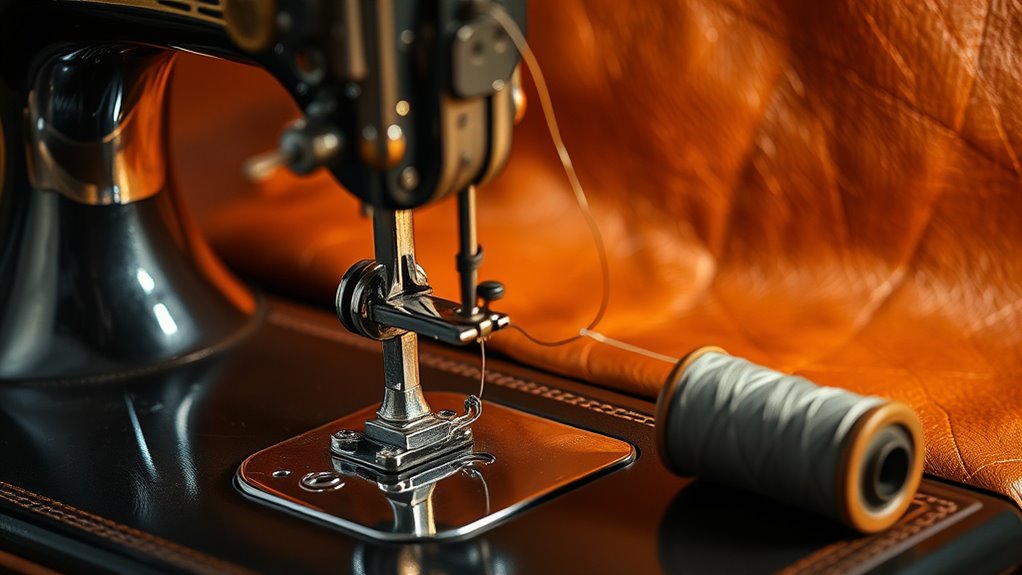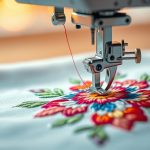Yes, sewing machines can sew leather, but you need to choose the right machine, needle, and thread for the best results. Use a walking foot machine for even feeding, and opt for heavy-duty needles (90/14 or 100/16) to handle thick leather. Select strong polyester or nylon thread to guarantee durability. Proper preparation and techniques are also essential. If you’re looking for tips on technique and troubleshooting, keep going for detailed advice.
Understanding Your Sewing Machine’s Capabilities
Understanding your sewing machine’s capabilities is vital for successfully working with leather. Different machine types have distinct features that impact their ability to handle various leather thicknesses.
For example, walking foot machines provide even feed for thicker leathers, while standard machines might struggle. You’ll want to check the machine’s motor strength; a powerful motor is important for sewing through multiple layers of leather. Additionally, the stitch length and tension settings can greatly affect your results.
If you’re working with heavier leather, verify your machine can accommodate it without skipping stitches. Always refer to your machine’s manual to understand its limits and capabilities, as this knowledge will help you select the right projects and techniques for successful leather sewing.
Choosing the Right Needle and Thread
Choosing the right needle and thread is essential for achieving professional results when sewing leather. Start with needle types; a heavy-duty needle, such as a size 90/14 or 100/16, is ideal for penetrating thick leather. Consider using a leather needle, which features a wedge-shaped point that effortlessly pierces through the material without causing damage.
Next, focus on thread materials. Polyester or nylon threads are recommended for their strength and durability, as they withstand the tension and stress leather projects often encounter. Opt for a thicker thread, such as 30 or 40 weight, to guarantee strong seams. By selecting the appropriate needle and thread, you’ll greatly enhance your leather sewing experience and the overall quality of your finished product.
Preparing Leather for Sewing
Once you’ve selected the right needle and thread, the next step is preparing the leather for sewing. First, identify the leather types: full-grain, top-grain, and suede, as they require different handling. Use appropriate cutting techniques to guarantee clean edges; a rotary cutter or sharp utility knife works best.
| Leather Type | Recommended Cutting Technique | Notes |
|---|---|---|
| Full-Grain | Sharp utility knife | Prevents fraying |
| Top-Grain | Rotary cutter | Guarantees accuracy |
| Suede | Scissors | Avoids damaging texture |
| Bonded Leather | Utility knife | Use a cutting mat |
Make certain the leather is clean and flat before cutting. This preparation is vital for achieving precise seams and a professional finish.
Techniques for Sewing Leather
Sewing leather successfully involves mastering several key techniques that can make or break your project. First, choose the right leather types, such as full-grain or top-grain, as their thickness and texture affect your stitching. Use a heavy-duty needle, typically a 90/14 or 100/16, to handle thicker materials.
When selecting stitch patterns, opt for straight or zigzag stitches, ensuring they’re spaced evenly to prevent tearing. Adjust your sewing machine’s tension settings for a smooth feed and avoid skipped stitches. Additionally, use a walking foot to maintain even pressure and prevent slippage. Finally, always test your techniques on scrap leather to perfect your approach before tackling your main project. With practice, you’ll achieve professional-looking results.
Troubleshooting Common Issues
Even with the right techniques and equipment, issues can arise when sewing leather that may hinder your progress. Understanding these common problems can save you time and frustration.
Even with proper techniques, sewing leather can present challenges that require awareness and adjustment for smooth progress.
- Needle Type: Verify you’re using a needle suitable for the specific leather types you’re working with; wrong needles can cause skipped stitches or damage.
- Sewing Speed: Adjust your sewing speed; too fast can lead to uneven stitching, while too slow may cause the needle to puncture excessively.
- Tension Settings: Check your tension settings; improper tension can result in puckering or loose stitches, particularly when working with thicker leather.
Frequently Asked Questions
Can I Use a Regular Sewing Machine for Leather Projects?
You can use a regular sewing machine for leather projects, but make certain you’ve the right needle size for the leather thickness. A larger needle helps penetrate thicker leather, reducing the risk of damage or skipped stitches.
What Types of Leather Are Easiest to Sew With Machines?
Soft leather, especially those under 2mm in thickness, are easiest for you to sew with machines. Look for materials like lambskin or suede, as their flexibility and lighter weight allow smoother stitching without damaging your machine.
Is It Necessary to Use a Walking Foot for Leather Sewing?
Using a walking foot isn’t strictly necessary, but it offers significant benefits, like even feed and reduced slipping. For leather sewing techniques, it helps guarantee precision, especially with thicker materials, enhancing your overall results.
How Do I Clean My Sewing Machine After Sewing Leather?
To clean your sewing machine after sewing leather, use a soft brush to remove debris, check the bobbin area, and apply cleaning oil as part of your maintenance routine. Regular cleaning tips keep your machine functioning efficiently.
Can I Sew Multiple Layers of Leather at Once?
Yes, you can sew multiple layers of leather, but consider layer thickness. Use proper sewing techniques like a walking foot and strong thread. Test on scraps first to avoid costly mistakes and guarantee a clean finish.


